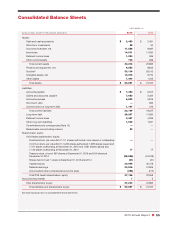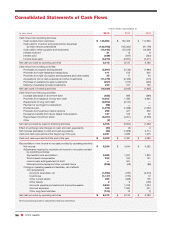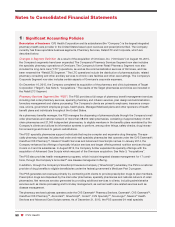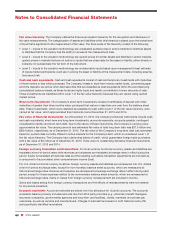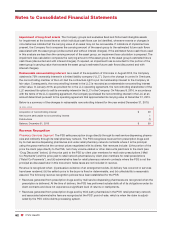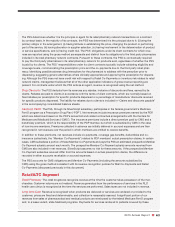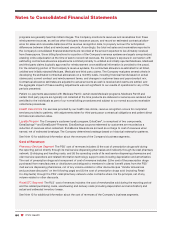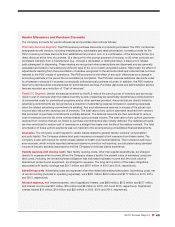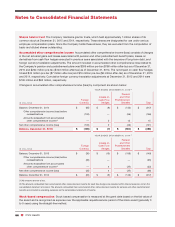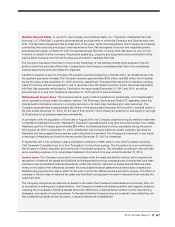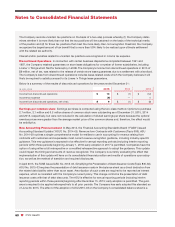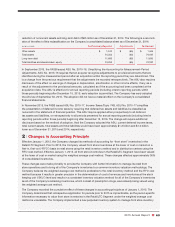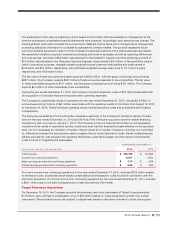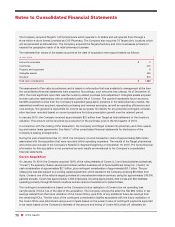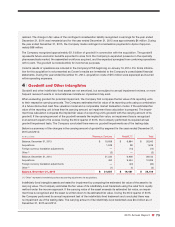CVS 2015 Annual Report Download - page 65
Download and view the complete annual report
Please find page 65 of the 2015 CVS annual report below. You can navigate through the pages in the report by either clicking on the pages listed below, or by using the keyword search tool below to find specific information within the annual report.
63
2015 Annual Report
The PSS determines whether it is the principal or agent for its retail pharmacy network transactions on a contract
by contract basis. In the majority of its contracts, the PSS has determined it is the principal due to it: (i) being the
primary obligor in the arrangement, (ii) having latitude in establishing the price, changing the product or performing
part of the service, (iii) having discretion in supplier selection, (iv) having involvement in the determination of product
or service specifications, and (v) having credit risk. The PSS’ obligations under its client contracts for which reve-
nues are reported using the gross method are separate and distinct from its obligations to the third party pharmacies
included in its retail pharmacy network contracts. Pursuant to these contracts, the PSS is contractually required
to pay the third party pharmacies in its retail pharmacy network for products sold, regardless of whether the PSS
is paid by its clients. The PSS’ responsibilities under its client contracts typically include validating eligibility and
coverage levels, communicating the prescription price and the co-payments due to the third party retail phar-
macy, identifying possible adverse drug interactions for the pharmacist to address with the prescriber prior to
dispensing, suggesting generic alternatives where clinically appropriate and approving the prescription for dispens-
ing. Although the PSS does not have credit risk with respect to Retail Co-Payments or inventory risk related to retail
network claims, management believes that all of the other applicable indicators of gross revenue reporting are
present. For contracts under which the PSS acts as an agent, revenue is recognized using the net method.
Drug Discounts
The PSS deducts from its revenues any rebates, inclusive of discounts and fees, earned by its
clients. Rebates are paid to clients in accordance with the terms of client contracts, which are normally based on
fixed rebates per prescription for specific products dispensed or a percentage of manufacturer discounts received
for specific products dispensed. The liability for rebates due to clients is included in “Claims and discounts payable”
in the accompanying consolidated balance sheets.
Medicare Part D
The PSS, through its SilverScript subsidiary, participates in the federal government’s Medicare
Part D program as a Prescription Drug Plan (“PDP”). Net revenues include insurance premiums earned by the PDP,
which are determined based on the PDP’s annual bid and related contractual arrangements with the Centers for
Medicare and Medicaid Services (“CMS”). The insurance premiums include a direct premium paid by CMS and a
beneficiary premium, which is the responsibility of the PDP member, but which is subsidized by CMS in the case
of low-income members. Premiums collected in advance are initially deferred in accrued expenses and are then
recognized in net revenues over the period in which members are entitled to receive benefits.
In addition to these premiums, net revenues include co-payments, coverage gap benefits, deductibles and co-
insurance (collectively, the “Member Co-Payments”) related to PDP members’ actual prescription claims. In certain
cases, CMS subsidizes a portion of these Member Co-Payments and pays the PSS an estimated prospective Member
Co-Payment subsidy amount each month. The prospective Member Co-Payment subsidy amounts received from
CMS are also included in net revenues. SilverScript assumes no risk for these amounts. If the prospective Member
Co-Payment subsidies received differ from the amounts based on actual prescription claims, the difference is
recorded in either accounts receivable or accrued expenses.
The PSS accounts for CMS obligations and Member Co-Payments (including the amounts subsidized by
CMS) using the gross method consistent with its revenue recognition policies for Mail Co-Payments and Retail
Co-Payments (discussed previously in this document).
Retail/LTC Segment
Retail Pharmacy
The retail drugstores recognize revenue at the time the customer takes possession of the mer-
chandise. Customer returns are not material. Revenue generated from the performance of services in the RLS’
health care clinics is recognized at the time the services are performed. Sales taxes are not included in revenue.
Long-term Care
Revenue is recognized when products are delivered or services are rendered or provided to the
customer, prices are fixed and determinable, and collection is reasonably assured. A significant portion of our
revenues from sales of pharmaceutical and medical products are reimbursed by the federal Medicare Part D program
and, to a lesser extent, state Medicaid programs. Payments for services rendered to patients covered by these




